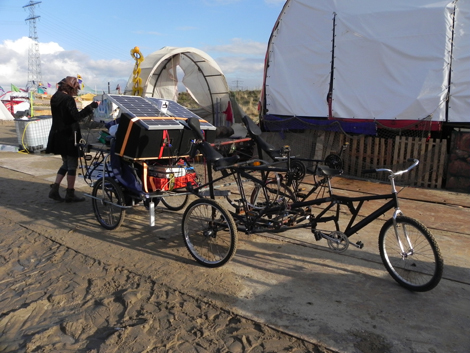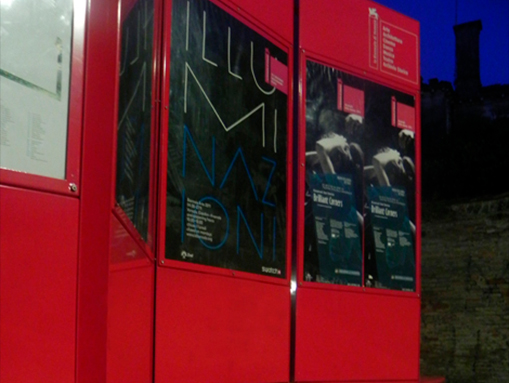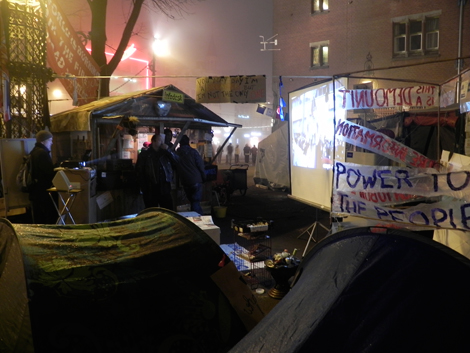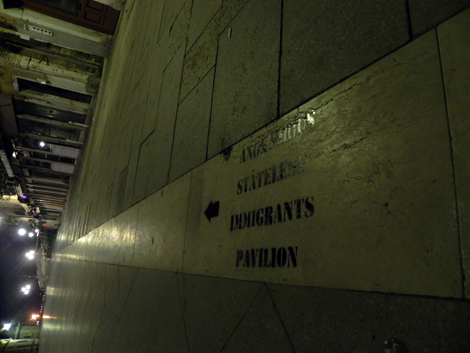INTERVIEW WITH EHSAN FARDJADNIYA
Ehsan Fardjadniya is an artist and activist based in Amsterdam. His project Pirate Cinema is part of Maldives Pavilion Events Program for the 55th International Venice Biennale of Art, 2013


Dorian Batycka: What is the Pirate Cinema?
Ehsan Fardjadniya: Pirate Cinema–a mobile moving-image installation powered by renewable energy. The Amsterdam version of the installation is a DIY, recycled and hacked machine! It is made of five wheels on a bike for three people to move forwards and produce electricity. For the Venice Biennale, we are making a new installation relating to the possibilities and limitations of the city. It is quite important to say that we are especially interested in independent filmmakers and producers and work together with many film festivals. We try to support the makers more than the intermediaries. Our films will be hardly seen in art film houses or at al in mainstream cinemas.
DB: Where did the impetus of your idea for Pirate Cinema come from?
EF: Pirate Cinema is a project that brings together many of my ideas into one project. In previous works I was mostly using props at public gatherings to open up a different interactive dialogue with them and/or between them. For example, to offer participants a situation where they can play Ping Pong and debate/complaints, or a mobile telephone kiosk to encourage them to call and deliver their complaints to their local government and, also, as in case of Occupy Amsterdam, an information installation, to facilitate occupiers with a mobile information hut as a central point to find information and publications and watch live streams and videos of co/occupiers.
DB: Direct actions in the streets often manifest very explicitly within your work, I’m thinking specifically of your other actions as ‘Crisis Manager’, including your Ping Pong intervention on election day at the PPV gathering outside the City Hall in den Haag, as well as other more direct forms of interventional critique that you often engage with. How do you conceive of art in relation to ‘public space’?
EF: As a foreigner I’m an outsider that needs to try to become an insider. Social immigration and understanding of the social codes have made my work mostly find its relevancy outside of traditional art and culture institutions. I try to integrate my works into the urban fabric itself, thereby trying to become more of an insider.
A basic need to communicate with my surroundings often forms the basis of my work and interventions. In these ‘social experiments’ I’m always confronted with urban rules and restrictions that make me question for example, how much of public space belongs to members of the public? How are democratic events and art in public space decided upon? Who designates what is public space and how much of that design is based on the desire of the public?
I’m thinking here of the anarchistic act of what is known as ‘Desire Paths’. I think by counting the amount of ‘Desire Paths’ in our urban space, we can begin to understand how desirable or intuitive our urban architecture is. Following those such as Benjamin Fraserin, who in his poignant critique of aesthetics and space concludes that modern urban planning from the 19 century onward has failed to produce an urban reality for users. Instead it has produced an urban reality only for urban capitalists, speculators, builders and technicians, and it’s done so according to a simplistic spatial logic that has reified city as a thing, a geometrical object.
I am especially interested in how we act and communicate in public space. The technological advances afforded by new developments in software, mobile media and communication, has had a huge impact on our urban architecture and culture. The ‘Smart City’ ideas by those such as IBM and Bill Gates is premised on gathering as much data as possible about our urban conditions by filling up cities with sensors and fast communication networks. These smart technologies will monitor the city- from the traffic circulations to air pollutants. The data of any so-called ‘Smart City’ is promised to make urban life easier, more efficient and more pleasant. Consequently, this will have a negative impact on humans as we lose our connection to the city itself. The easier, efficient and more pleasant urban life is partially true, but what we should not forget is that the outcome of smart technologies has and will change our community and collectiveness. The American architect critic Paul Goldberger questions how members of the public start creating relationships with their physical surroundings. He asks, do they still take an active part in communal living or withdraw into ‘cocoons’ created via mobile telephones? In sum, my work problematizes the idea of what informs our bodies in both the public and private sphere, and how mobile information technologies have informed this precarious situation.


Anyway, I’m sure you remember our motivation wasn’t necessarily direct actions against what you call the ‘hegemonic institution’, but rather a general frustration we both felt about permanent nations and the idea of representation. Or, more specifically – the limitations and obstacles we face due to geopolitics. We were at a very specific moment in our lives, a moment with a few friends from Russia, Columbia and yourself from Canada, all united in Amsterdam, and all with visa problems and unsure of what nationality meant as a concept. Around this same time, there was a giant influx of immigrants who came to the south of Italy, in Lampedusa. Given that the art world at the Venice Biennial showed no concern with this issue, instead were busy sending out e-flux posts, we thought of the title: Stateless Immigrants Pavilion. We titled our press release: e-flux doesn’t represent Stateless Immigrants Pavilion. I remember we had many late night discussions about whether to have a venue or maybe a series of tents and to show artworks. But finally we again took an outsider position by not having any pavilion or artworks and chose to make path marks to a nonexistent pavilion. A detour that can’t be found by any GPS navigation screens or tourists maps, instead by direct observation of one’s surroundings. To express the non-existence of such a pavilion instead of creating one in a traditional way showing art objects, this was the idea.
This year the situation is markedly different. We are participating in Maldives Pavilion as a satellite project with Pirate Cinema project, which is meant for outdoor performances. This makes us outsiders again, which I still prefer. I mean at the beginning of the project there were two basic ideas: first that Maldives pavilion will bring together a network of activists to discuss and act on the global warming issues and political turmoil of Maldives especially in the recent case of Maldives Ex-president Mohamed Nasheed.
Second, the idea was to have no venue but instead a mobile pavilion. These two initial ideas sounded very much in parallel with my practice and what Pirate Cinema is based upon. Right now, the project has found a venue and doesn’t seem to relate itself much or at all with the pressing issue in the Maldives. On the contrary, we seem to be commissioned by the current government to represent Maldives at 55th Venice Biennale. I would rather be an outsider to this present situation and act against this cultural coup.
DB: This brings me to wonder about the dialectical method that seems to frame much of your work, even formally within actions like Ping Pong – where the ball continually moves back and forth over the table, just like the political ideas being discussed by the participants. What role do you think dialectics has to play in the production of critical contemporary art?
EF: Emm… Dorian, I don’t know what to say here. Can you ask something smart, please?
DB: OK OK, I digress… art and activism have a somewhat tenuous relationship, with artists on the one hand often occupying an extremely privileged position within society, along with responsibilities to voice popular concerns. I’m wondering if you could elaborate a little on how you conceive of the relationship between art and activism?
EF: Not everyone can enjoy the luxury of indifference!
DB: Lastly, how do you feel large-scale exhibitions such as the Venice Biennale function in relation to normalizing and subsuming critique into forms of spectacle? Do you feel there is any hope for large-scale exhibitions of contemporary art? Or are they all pure shit?
EF: I can say that in case of the Maldives, it seems to be more than a normalization of potentials of a critical project. I still do not understand the motives of curatorial changes in the project but I hope to be informed. My question here is would our request to represent Maldives as outsiders have been accepted by Venice Biennale officials without official letter from the current Maldives government?
In my opinion, the Venice Biennale is one of the last large-scale contemporary art exhibitions, which have empowered critical thinking. However, there are too many words and gestures of critical thinking that changes immediately to symbolic jests in the deserted reality garden of powerful nations. Words, terms, publications and press releases need to sound intelligent, critical and contemporary, otherwise you are an outsider to private parties at yachts. In the first weeks of the Biennial the art world is just partying and showing it’s wealth to the world as the history of Venice dictates. Please give up any hope of changing the world if you are participating in the Venice Biennale. I’m much more interested in what will happen after Venice…
Pirate Cinema is supported by:



